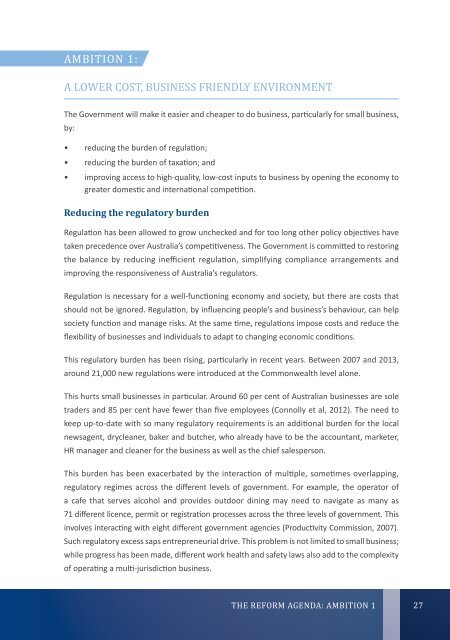Industry-Innovation-and-Competitiveness-Agenda
Industry-Innovation-and-Competitiveness-Agenda
Industry-Innovation-and-Competitiveness-Agenda
You also want an ePaper? Increase the reach of your titles
YUMPU automatically turns print PDFs into web optimized ePapers that Google loves.
Ambition 1:<br />
A lower cost, business friendly environment<br />
The Government will make it easier <strong>and</strong> cheaper to do business, particularly for small business,<br />
by:<br />
• reducing the burden of regulation;<br />
• reducing the burden of taxation; <strong>and</strong><br />
• improving access to high-quality, low-cost inputs to business by opening the economy to<br />
greater domestic <strong>and</strong> international competition.<br />
Reducing the regulatory burden<br />
Regulation has been allowed to grow unchecked <strong>and</strong> for too long other policy objectives have<br />
taken precedence over Australia’s competitiveness. The Government is committed to restoring<br />
the balance by reducing inefficient regulation, simplifying compliance arrangements <strong>and</strong><br />
improving the responsiveness of Australia’s regulators.<br />
Regulation is necessary for a well-functioning economy <strong>and</strong> society, but there are costs that<br />
should not be ignored. Regulation, by influencing people’s <strong>and</strong> business’s behaviour, can help<br />
society function <strong>and</strong> manage risks. At the same time, regulations impose costs <strong>and</strong> reduce the<br />
flexibility of businesses <strong>and</strong> individuals to adapt to changing economic conditions.<br />
This regulatory burden has been rising, particularly in recent years. Between 2007 <strong>and</strong> 2013,<br />
around 21,000 new regulations were introduced at the Commonwealth level alone.<br />
This hurts small businesses in particular. Around 60 per cent of Australian businesses are sole<br />
traders <strong>and</strong> 85 per cent have fewer than five employees (Connolly et al, 2012). The need to<br />
keep up-to-date with so many regulatory requirements is an additional burden for the local<br />
newsagent, drycleaner, baker <strong>and</strong> butcher, who already have to be the accountant, marketer,<br />
HR manager <strong>and</strong> cleaner for the business as well as the chief salesperson.<br />
<strong>Industry</strong> <strong>Innovation</strong> <strong>and</strong> <strong>Competitiveness</strong> <strong>Agenda</strong><br />
In<br />
Co<br />
This burden has been exacerbated by the interaction of multiple, sometimes overlapping,<br />
regulatory regimes across the different levels of government. For example, the operator of<br />
a cafe that serves alcohol <strong>and</strong> provides outdoor dining may need to navigate as many as<br />
71 different licence, permit or registration processes across the three levels of government. This<br />
involves interacting with eight different government agencies (Productivity Commission, 2007).<br />
Such regulatory excess saps entrepreneurial drive. This problem is not limited to small business;<br />
while progress has been made, different work health <strong>and</strong> safety laws also add to the complexity<br />
of operating a multi-jurisdiction business.<br />
TPO00007<br />
The Reform <strong>Agenda</strong>: Ambition 1<br />
27


